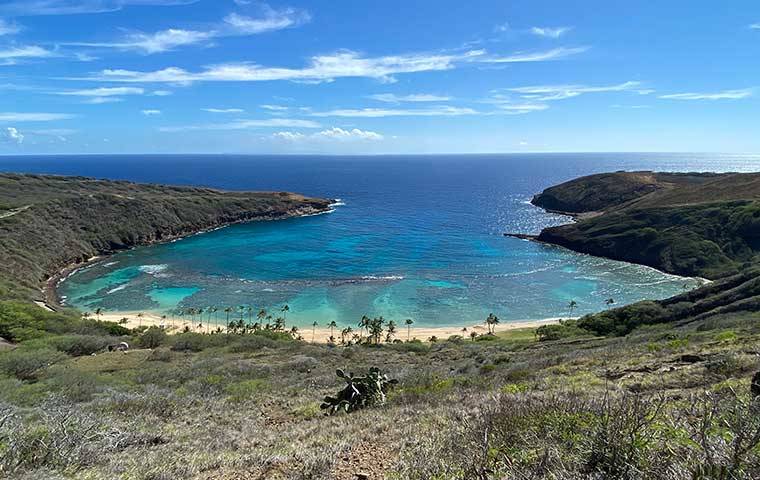Hanauma Bay reopens following 8-month COVID-19 closure

CINDY ELLEN RUSSELL / CRUSSELL@STARADVERTISER.COM
Hanauma Bay Nature Preserve as seen this morning. The bay reopened to visitors today after being closed since March due to COVID-19.
After having been closed since March due to the novel coronavirus Opens in a new tabpandemic Opens in a new tab, Hanauma Bay Nature Preserve reopened to the public at 8 a.m. today in a pilot project, with new limitations on visitor numbers, days and hours of access and other restrictions, the Honolulu City and County Department of Parks and Recreation announced in a press release this morning.
Only 720 people will be admitted per day, and the bay will be closed every Monday and Tuesday; Hanauma Bay was formerly closed to the public only on Tuesdays and Christmas and New Year’s days.
Pedestrians and vehicles will be allowed to enter from 8 a.m. to 2 p.m., and all visitors must leave the preserve by 4 p.m.
In 2019, average daily attendance was almost 3,000 people, and Hanauma Bay received nearly 845,000 visitors that year.
After eight months without human visitors, save for socially distanced groups of no more than five scientists or conservation organization members conducting research for the state and city, the pilot project’s intent is to balance public enjoyment of the dramatic natural arena of the bay and the educational opportunities it provides with public safety and protection and preservation of the coral reef habitat and its denizens, the city said in a press release.
“We are thrilled to be able to invite the public back to one of the most spectacular features on O‘ahu, while modifying how we manage this nature preserve to keep it thriving for generations to come,” Mayor Kirk Caldwell said in the release. “All of these measures are in place to balance conservation efforts, safety of the public and staff, and the ability to responsibly enjoy this world class environmental feature.”
Don't miss out on what's happening!
Stay in touch with breaking news, as it happens, conveniently in your email inbox. It's FREE!
To comply with COVID-19 restrictions, face covering mandates apply at all times within Hanauma Bay, and social distancing will be required.
The new rules are as follows:
>> Capacity will be limited to 720 people a day.
>> Vehicular and pedestrian entry will be allowed from 8 a.m.- 2 p.m. and all visitors must have left by 4 p.m.
>> Hanauma Bay will be closed Mondays, Tuesdays and Christmas and New Years days.
>> Entry into the parking lot, the reserve and its theatre will be limited to 30 individuals at a time. Once that group enters the theatre to watch a mandatory educational video, the next group will be allowed to enter.
>> Entry and parking fees for nonresidents of Hawai‘i have increased as follows: $3 parking fee for nonresidents; $12 entry for nonresidents; free entry for Hawai‘i residents (with valid ID) and children 12 years and younger
>> No commercial activities will be allowed to operate in or transport visitors into Hanauma Bay.
>> The gift shop, education center, food concession, snorkel and locker rental facilities will remain closed; visitors must bring their own snorkel equipment.
>> Bathrooms and showers within Hanauma Bay will be in operation.
>> City bus service into Hanauma Bay will continue to be suspended.
The release said that while the closure since March 18 has resulted in no revenue from ticket sales to support HBAY operation, on the plus side, clearer water and larger fish returning to the nature preserve have been observed.
“As a fiscally responsible nature preserve, Hanauma Bay has served as an amazing model of how to focus on both the recreational needs of the community and the conservation of its natural resources,” said Michele Nekota, Director of the Department of Parks and Recreation. “We see these new operations as a pilot program, which we hope can improve efforts to learn from, enjoy, and maintain Hanauma Bay in this pandemic era.”
A historically significant location for Native Hawaiians, Hanauma Bay was designated the state’s first Marine Life Conservation District in 1967.
In the 1970s and 1980s visitor attendance peaked at an estimated 10,000 people a day. A management plan implemented in 1990 sought to mitigate human impact by reducing visitation, improving facilities, banning the feeding of fish, and educating bay visitors.
“We’re looking to see how well this pilot program works for both the resource and the people,” said Nathan Serota, DPR public information officer of the deeper visitation cuts.
Scientists will now start surveying fish and marine mammal and honu behavior, water clarity, coral health and other ecological bellwethers as humans resume use of the bay, and comparing the data they collect with 8 months’ worth of observations and measurements during the long hiatus in snorkellers, swimmers and waders, Sarah Severino, who has been conducting weekly research at Hanauma Bay throughout its closure for the Coral Reef Ecology Lab in the Marine Biology Department of the University of Hawaii at Manoa.



